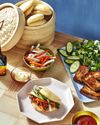
From space, Earth looks like a planet overflowing with water. But only about 0.007 percent is fresh and usable, and even that amount is under threat.
Whether for drinking, cooking, bathing, washing clothes, or other basic tasks, the average American uses around 80 gallons of water a day—but that’s just a fraction of their total usage. There’s an additional 2,000 gallons “hidden” in what one consumes on a daily basis.
It may be strange to think about the water we use yet can’t see. Scientists have made that hidden number visible by calculating what is known as a water footprint. Consider one tomato. Its carbon footprint measures how many pounds of planet-warming gas are added to the atmosphere to grow, wash, pack, and deliver the tomato to you; its water footprint tells you how much water it takes to do the same.
The numbers are staggering. In one day a family of four exhausts enough water to overflow an 18-foot aboveground swimming pool. And the biggest contributor is in what we eat. Almonds, for example, are famously exorbitant: Producing one pound can demand up to 1,900 gallons of water (though California almonds, which constitute most of the world’s stockpile, use a more efficient 700 gallons per pound).
This doesn’t mean we have to stop eating almonds. But we can make smarter overall choices. The best way to reduce your water footprint? Consider eating less red meat. When possible, opt for poultry or ocean-caught fish. Veggies, pound for pound, have lower impact compared to fruit, meat, or nuts. Switching to a vegetarian diet can cut one’s water footprint by about 18 percent; a vegan diet by about 25 percent.
Bu hikaye Bon Appétit dergisinin May 2023 sayısından alınmıştır.
Start your 7-day Magzter GOLD free trial to access thousands of curated premium stories, and 9,000+ magazines and newspapers.
Already a subscriber ? Giriş Yap
Bu hikaye Bon Appétit dergisinin May 2023 sayısından alınmıştır.
Start your 7-day Magzter GOLD free trial to access thousands of curated premium stories, and 9,000+ magazines and newspapers.
Already a subscriber? Giriş Yap

The Bargaining Table
To face her toughest critic, chef Michelle Bernstein of Miami's Cafe La Trova empowers her kid with choice

Into the Woods
The only thing standing between me and a perfectly executed faux sick day was...a cake

Built to Last
California design studio Commune outlines sustainable strategies for kitchens

In the Limelight
At Este in Austin, pastry chef Derrick Flynn's Oaxacan crema semifreddo is like a Key lime pie that went on vacation to the Mexican coast

VEGAN FOR EVERYONE
This one's for the vegans, and the sometimes vegans, and the never vegans, and anyone who wants a fast, filling, and delicious weeknight dinner that also happens to be vegan

Trash Talking
At Shuggie's in San Francisco, everything is garbage and that's a good thing

DIGGING AT THE ROOTS
In her latest book, Ever-Green Vietnamese, beloved teacher and food writer Andrea Nguyen takes a closer look at the plant-centric origins of her culinary heritage

DO YOU KNOW YOUR WATER FOOTPRINT?
You’ve heard of a carbon footprint. But hinking about its lesser-known counterpart is becoming ever more urgent

Take It Slow
For Pierce Abernathy and environmental art collective Aerthship, mindful eating is a way of life

Soufflé for Seder
Claire Ptak, owner of London bakery Violet, makes a lofty molten chocolate cloud that's kosher for Passover